What will grow in this spot? Climate Zones & microclimates
—Bulbs, Corms, Tubers, Rhizomes
Also Check out my article at the Westside Home & Garden:
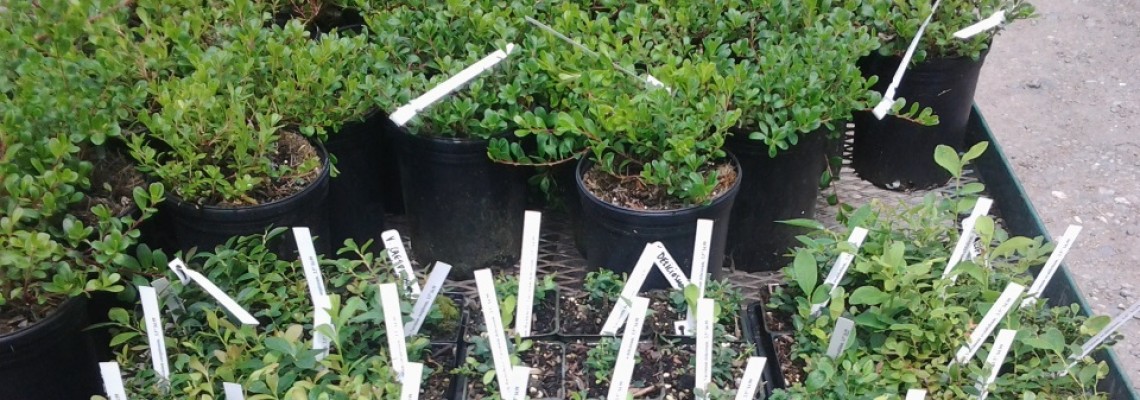
What will grow in this spot? Climate Zones & microclimates
—Bulbs, Corms, Tubers, Rhizomes
Also Check out my article at the Westside Home & Garden:
Unlike people most plants are unable to move when drought, cold or other dangers threaten their survival. However, many plants have evolved strategies to help them survive through difficult times: They go dormant. Just like a hibernating animal, they store up food prior to withdrawing underground and going to “sleep.”
Not all underground structures are roots; many are modified from stem tissue. The purpose for most is either food storage, or to help the plant spread more quickly to surrounding areas.
The bulb is the most well-known underground structure. It is a short stem with thickened fleshy leaves. A bulb can be layered as an onion or scaly like a lily bulb. Most bulbs are monocots in the onion, lily (which includes tulips & hyacinths), amaryllis (which includes daffodils), and iris families. Camas bulbs were an important food for native people, but they also have attractive blue or white flowers. They grow in vernal wet meadows that dry up in the summer. Other attractive natives with bulbs include Nodding Onion, Chocolate Lily and Tiger Lily.
A corm is a short, vertical underground stem with thin, papery leaves. Plants with corms include crocus, and gladiolus. Native flowers that have corms are Fawn, Avalanche, and Glacier Lilies. Just as for bulbs, corms may help a plant survive a dry summer or a long winter. It’s especially useful for alpine flowers that only have a couple months to grow and bloom when they are not blanketed with several feet of snow.
A rhizome is a creeping, horizontal stem. Rhizomes help a plant spread more quickly to surrounding areas. It may also store extra food. Plants with rhizomes include ginger, canna, orchids, some irises, some grasses and many ferns. Plants with rhizomes, such as bamboo, can be very aggressive. Rhizomatic grasses are some of the most troublesome weeds. Rhizomes can help a plant survive many aboveground disasters, such as forest fires. Desirable plants with rhizomes are often easy to propagate by division. Native species that have rhizomes include Cattails, Solomon’s Seal, False-lily-of-the-valley, Vanilla Leaf, Inside-out Flower, Pacific Bleeding Heart, Redwood Sorrel, Wild Ginger, Bunchberry, and many ferns. Trilliums also have short fleshy rhizomes.
A tuber is an underground stem or rhizome modified for food storage, bearing nodes and buds or “eyes.” The most famous is the potato. The potato was native to Peru and Chile but quickly spread to become a staple crop throughout much of the world. The Potato Blight is a fungus disease that caused the infamous Irish Potato Famine in the late 1840’s. The edible tubers of Oca, a type of oxalis, also native to the Andes, are gaining popularity. They are high in oxalic acid similar to Rhubarb. I bought some from Raintree Nursery, but have yet to taste them. Cyclamen and tuberous begonias also have tubers. The tubers of Wapato, a native pond plant, were eaten by natives, either boiled or roasted.
A tuberous root is a thickened root that resembles a tuber. It serves the same purpose of food storage as a stem tuber, but is derived from root tissue. Sweet Potatoes and dahlias are examples.
The leaves of some flowering bulbs may sometimes become unsightly, but you should allow them to grow and manufacture food for next year. Most bulbs do best with little or no irrigation in the summer.
If you buy a new home, it is best to wait a year before you do any major landscaping; there may be botanical treasures hidden beneath the surface!
(This article was first published in the Peninsula Gateway on May 8, 2013 as “Underground structures key to plant growth.”)
In order to be a successful gardener, you need to know what a plant needs to grow. Plants are nature’s solar collectors. In order to perform the miracle of photosynthesis, plants need carbon dioxide from the air, water from the soil or air, and sunlight to form carbohydrates and give off oxygen:
 Photosynthesis is how plants make food for all life on earth (except for extremophiles that live in geochemically active areas such as underwater volcanoes and hot springs).
Photosynthesis is how plants make food for all life on earth (except for extremophiles that live in geochemically active areas such as underwater volcanoes and hot springs).
The opposite of photosynthesis is respiration. All plants and animals respire when they unlock the energy stored in the carbohydrates that were created through photosynthesis.
Other elements are also necessary for plant growth. When I was in school I learned a mnemonic to help remember nutrients essential for plant growth: C HOPKiNS CaFé Mg’ed By Mne CuZns Mo & Cleo. Since then a few more elements have been discovered to be essential or beneficial for plant growth: Co, Ni, Si, Na, V, Se. In the following paragraphs, I list just some of the key roles and benefits of these elements play in plant growth.
The first three, Carbon, Hydrogen and Oxygen are essential for photosynthesis and respiration as described above in the form of carbon dioxide (CO2), oxygen (O2 ), and water (H2O).
The next three are the primary macronutrients; represented by 3 numbers as percents on a fertilizer bag: Nitrogen : Phosphorus : potassium (K). Nitrogen is absorbed as nitrate (NO3–) or ammonium (NH4+). It is necessary for the formation of amino acids, the building blocks of protein and is directly involved in energy reactions such as photosynthesis and respiration and is essential for cell division and plant growth. Phosphorus is absorbed as phosphate (H2PO4–). It is also involved in energy reactions and cell division. It promotes root growth and improves the quality of fruits, vegetables, and seeds. Potassium (K+) activates enzymes and is essential for protein synthesis. It also is important for the formation of starch and the translocation of sugars. It regulates the opening and closing of stomata and improves winter hardiness, drought tolerance and increases disease resistance. You can purchase test kits that will tell you if you need to add these nutrients to the soil—Nitrogen needs to be replenished most frequently.
Secondary in importance are calcium (Ca++), magnesium (Mg++) and Sulfur in the form of Sulfate (SO4—). Calcium is an important structural element in cell walls. It is important for cell division and formation. It is also necessary for good fruit set. Magnesium is a key element used in chlorophyll production and activates many plant enzymes. Sulfur is an integral part of amino acids and helps develop enzymes and vitamins. It also promotes nodule formation in legumes.
Micronutrients are used in very small amounts but are still very important for plant growth. Iron (Fe+++) is required for the formation of chlorophyll. It carries oxygen and is an activator for many biochemical processes. Boron is absorbed as borate (H2BO3–). It is essential for the formation of cell walls and seeds, pollen germination and growth of pollen tubes. Manganese (Mn++) aids in chlorophyll synthesis and activates many enzymes systems. Copper (Cu++) catalyzes several reactions and performs major functions in photosynthesis and reproduction. Zinc (Zn++) aids plant growth hormones, enzyme systems and seed formation. It is necessary for chlorophyll production, and carbohydrate and starch formation. Molybdenum is absorbed as molybdate (MoO4–). It is required to form enzymes that convert nitrate to ammonium and inorganic phosphates to organic phosphates. Chlorine or Chloride (Cl–) aids photosynthesis and is involved in osmotic transfer regulating the opening and closing of stomata. With some exceptions, micronutrients are rarely deficient. Check with your local extension agent to find out which are likely to be deficient in your area—some crops are more sensitive to certain deficiencies and are more likely to exhibit typical symptoms of deficiency.
The following elements have also been found to be beneficial in some plants. Cobalt (Co++) is required for nitrogen fixation in legumes. Nickel (Ni++) is needed for enzymes that break down urea to available nitrogen and is required for seed germination and iron uptake. Silicon is taken up as silicic acid (H4SiO4). It is a component of cell walls, helps resist insects and disease and improves heat, drought and cold tolerance. Sodium (Na+) can substitute when potassium is deficient. It is used more often in desert and seaside plants. Vanadium is essential for green algae and may be beneficial to larger plants in small quantities. In large quantities, vanadium interferes with the uptake of phosphorus (H2VO4–substitutes for H2PO4– )—It has been referred to as “junk food” for plants. Selenium is taken up by some plants and may be beneficial for some, but it is toxic to others.
Because of all these nutritional needs I find that it is much easier and less expensive to grow plants in soil, where they may be able to absorb essential micronutrients, naturally. High Tech systems such as Hydroponics are expensive and failure is common because of missing nutrients or system design flaws and/or maintenance issues.
Plants may absorb other minerals—even gold. Many cause no problems; others are pollutants that are toxic to plants and/or the consumers of plants.
Temperature plays a key role in many of the chemical reactions involved in plant growth. Most plants are able to grow at warm temperatures unless water is a limiting factor. Many plant species are adapted to grow at colder temperatures. The USDA plant hardiness map shows different regions in the United States based on average minimum temperatures. Most garden encyclopedias will give hardiness zones for each listed species. This is to help you determine if a plant you are interested in will survive in your climate. In the western states, a better system is used in the Sunset Garden Encyclopedia—it takes other climate variables into account. Consulting hardiness zones for native plants is usually not necessary—they should already be adapted to your climate!
 Proper placement of plants in the landscape is critical to gardening success. One of the most challenging jobs at the nursery is figuring out where to put plants to grow them on so they will grow strong & healthy and most importantly– not die. Knowledge of the specific needs of each plant species is essential and is probably the most important reason to consult a professional horticulturist or experienced gardener when investing in plants for a new landscape. Even some landscape designers, although they may come up with beautiful plans, are sometimes weak when it comes to knowledge of how specific plants will perform in their intended locations.
Proper placement of plants in the landscape is critical to gardening success. One of the most challenging jobs at the nursery is figuring out where to put plants to grow them on so they will grow strong & healthy and most importantly– not die. Knowledge of the specific needs of each plant species is essential and is probably the most important reason to consult a professional horticulturist or experienced gardener when investing in plants for a new landscape. Even some landscape designers, although they may come up with beautiful plans, are sometimes weak when it comes to knowledge of how specific plants will perform in their intended locations.
Many garden books refer to the USDA Plant Hardiness Zone Map which shows the average minimum temperature for each area. It is really only useful to tell you which plants may be killed in winter. The Puget Sound region is in zone 8b (15-20F); this is the same zone listed for Austin, Texas and Gainesville, Florida. Sunset Western Garden Book zones are more helpful. Our Sunset zone is 5–“Marine influence along the Northwest coast, Puget Sound and Vancouver Island;” it takes into account our longer growing season and relatively cool summers with low heat accumulation.
These zone systems are helpful to determine what plants will grow in our region, but other factors such as the amount of light and moisture, and type of soil will influence what will grow in a particular location. Most garden books will tell you whether plants need full sun, partial shade or full shade, and may also tell you their water requirements. When planning a landscape it is important to be aware how much shade an area will get throughout the day– from trees or buildings. Although the Northwest is famous for its rain, July & Aug. are usually dry. Many of our native plants are actually killed by summer irrigation. It is best to have separate areas for water-loving plants and those that need it drier.
The type of soil you have in your yard may also limit what you can grow. Most of our soils, derived from glacial till, are sandy loam to clay loam, with medium acidity, and moderate to high organic matter. You can usually improve soils by the addition of organic matter, but it is more difficult to correct drainage problems. Nonnative plants may benefit from an application of lime to raise the pH of the soil.
Topography has the biggest effect on microclimates. It can affect temperature, light, moisture, and soils. A southern or western slope will be warmer, brighter and drier than a northern or eastern slope. Cold air, like water, will drain down to the bottom of hills & depressions. Soils are also shallower on steeper slopes.
Buildings and other structures, similarly, may create microclimates. Urban environments are much warmer than rural areas due to concrete and asphalt absorbing and retaining heat. The south and west side of buildings are much warmer due to the same “heat sink” effect of many building materials. Conversely, buildings create shady areas on their north and east sides. Nurseries often build shade houses to shelter plants that grow better with less sun. Fabrics with different shade ratings draped over an open structure, have mostly replaced old-style lath houses.
A little research on the plants you plan to buy will help to ensure that you can match them with their intended location. Putting the right plant in the right place will increase your gardening success–but weather anomalies will always create challenges even for experienced gardeners.
(This article was first published in the Peninsula Gateway on August 17 2011.)
Shrubs and trees are often used in the landscape to create barriers. Privacy screens are the most common, either to prevent other people from seeing into an area, or to physically keep them out. Often screens are planted to block out traffic noise. Sometimes they are merely used as a design element to cover an unsightly view or to create a secluded nook within a garden. Historically, the classic English hedgerow was used instead of fences to create boundary lines between properties and pasturage, often providing the only refuge of shelter for remnant wildlife populations.
Being a “green” gardener, I try to discourage people from planting single-species hedges. Personally, I think they are boring, and if shearing is required, too much work. A mixed-species screen is more interesting and provides better habitat for wildlife.
When deciding what type of plants you want in a hedge or screen, first you need to decide how much room you have—how wide and what heights are desired or acceptable. Unfortunately, if you have limited space your choices of plant material are severely limited. That is why arborvitaes, Thuja occidentalis varieties, are so popular; the columnar types fit in narrow areas and stay neat without shearing and can usually be purchased inexpensively. Many other cultivated conifer varieties are also suitable.
Most people want plants that are fast growing to quickly fill in the space, but such plants can quickly become a problem too. Popular hedge species such as the English Cherry Laurel, Prunus laurocerasus, and the red-leaved Photinia x fraseri easily get out of hand even if they are sheared regularly.
English yew, Taxus baccata, is the traditional species for mazes and topiary. It is long-lived and can take much shearing and pruning but because it is slow growing, it requires patience (it also can be expensive initially!).
I recommend using natives when possible, but unfortunately unless you have space for tall conifers, such Cedars, Hemlocks and Firs, there are few good choices of shrub-size native evergreens. Tall Oregon Grape, Mahonia aquifolium, is one of the best, but it has prickly leaves that may not be desirable for some applications. Evergreen Huckleberry, Vaccinium ovatum, and Salal, Gaultheria shallon, are so slow growing; they will probably not achieve the desired height for many decades, although they could still be a part of the overall design.
For some better choices we can look further south. The fragrant, Pacific Wax Myrtle, Morella (Myrica) californica, is related to the eastern Bayberry. The California Bay Laurel (Oregon Myrtle), Umbellularia californica, is also fragrant but gets very big. The Coast Silk Tassel, Garrya elliptica, has attractive, long catkins in late winter.
Leyland Cypress, Cupressocyparis leylandii, is a hybrid of our native Alaska Yellow Cedar and the California native, Monterey Cypress. It is a popular fast growing tree often used for screening.
Some exotic species will fit nicely into northwest landscapes. The Strawberry Tree, Arbutus unedo, related to our native Pacific Madrone, comes from the Mediterranean. Pieris varieties have clusters of white or pink flowers, pink or reddish new growth and fit in well with rhododendrons. Evergreen Barberries, Berberis sp., have bright yellow flowers like their relative, Oregon Grape, and large thorns to keep people and animals out! Escallonias, from Chile have pretty pink flowers. Osmanthus species have fragrant white flowers. Evergreen Euonymous varieties have interesting variegated leaves.
As for any garden design project, thought should be given as to how plants in your hedgerow will change through time and what possible maintenance will be required. It should bring you joy—not just more work!
(This article was first published in the Peninsula Gateway on November 18, 2009.)
 Often when we are planning new landscapes we think only of aesthetic qualities. It is important, however, to think about other possible functions. You should begin by asking: What do I want my landscape to provide?
Often when we are planning new landscapes we think only of aesthetic qualities. It is important, however, to think about other possible functions. You should begin by asking: What do I want my landscape to provide?
The first thing to consider is how your landscape will be used. Do you want a place to play? A lawn is good for athletic games & activities, a place to frolic with kids, dogs or other pets, or for toddlers to experience the wonder of the outdoors. Perhaps you want an outdoor living space, a pleasant place to barbecue and entertain family and friends…or a private, peaceful garden to meditate in or curl up with a good book.
Begin by planning a basic layout. Paths may be necessary to allow access to different parts of your garden. A screen creates privacy or covers up an unsightly view. A fence can keep kids or pets in and/or unwanted trespassers out.
Do you intend to grow food for your family? Fruit trees and shrubs can be incorporated into any landscape plan, or you may want to set aside an area for vegetable & herb gardens.
You can restore habitat and encourage native wildlife by planting native plants. Growing plants with berries, nuts and seeds will attract songbirds and squirrels. Flowers attract hummingbirds & butterflies—and remember that insects, worms and other small critters also play an important role in the web of life.
The maintenance and irrigation requirements of your landscape also should be considered. How much time and money are you willing to spend on the upkeep of your yard? Do you want it to pretty much take care of itself, except for a little weeding every few weeks, or are you willing to be mowing, edging and trimming regularly…or perhaps you have a lot of time to enjoy puttering in the garden every day.
Once you decide on your functional goals, then you can start designing a plan for your dream garden. Whether you want to follow any special theme or not, you need to select plants that will thrive in the varying microclimates of your yard; matching each plant with its preferred amount of sun, shade and moisture.
When designing, use the following principles of design: Scale, make sure the current and future sizes of the plants fit well into your design scheme. Form, think about the overall shape of each plant, and how they will look next to other plants. Texture, does the plant have bold, large leaves, or fine, graceful foliage; what effect do you want to portray? Color, leaves may be various shades of green, variegated with white, yellow, or even purple, changing with the seasons to scarlet, orange or yellow in the autumn. What are your favorite flower colors? Berries and twigs also add color in the winter. Focus, providing focus points draws the viewer’s eyes to certain spots in the landscape, creating a more relaxing environment than a chaotic jumble of colors, forms & textures. Balance, when viewing from different perspectives, create a balance of large & small, bold & graceful, and bright & muted colors; this subconsciously assures us that all is right and balanced.
Trees, such as Quaking Aspens, add movement as well as the sound of the wind rustling through its leaves. Soft or fuzzy plants are pleasant to “pet.” Fragrant flowers and foliage and sweet fruit delight other senses. Unlike other art forms, landscapes change with time, adding a 4th dimension to consider. A landscape can be beautiful and fulfill many functions.
(This article was first published in the Peninsula Gateway on December 19, 2012)
Humans have impacted every part of this planet to a lesser or greater degree. In the following discussion, I classify different types of human habitats—where people live and work for most of their lives. For each habitat, I will attempt to suggest ways in which the ecology can be improved for plants, wildlife and the entire web of life. By doing so, my hope is that we not only preserve many other species on our planet but may also save human civilizations from collapse by preventing future scarcity of the organisms that sustain our species. Sharing our world with other species not only is necessary but it makes it a more beautiful place to experience life.
An Ancient Native American Proverb often attributed to Chief Sealth states: “Treat the earth well: it was not given to you by your parents; it was loaned to you by your children. We do not inherit the earth from our ancestors; we borrow it from our children.” Another proverb takes it even further: “In every deliberation, we must consider the impact on the next seven generations…” If you think about how much the world has changed in the last 200 years—it is very difficult to imagine what the world will be like 200 years from now! My ancestors, 7 generations ago lived in the 1700’s and early 1800’s. (We all have 27 or 128 ancestors of that generation.) The ones of mine that I know about lived in Colonial America, mostly Pennsylvania, New Jersey, Virginia and North Carolina. A little more than half of my lines immigrated later so were still in Germany and Ireland at that time.
Whether we rent or own, most of us have control over a portion of land. There is often heated debate over “property rights.” Some feel that they should be able to do whatever they want on their property. But the fact is, what people do on their land may have severe impacts on their neighbor’s quality of life and the overall ecology of the area. That is why there are zoning restrictions and permitting processes. How much regulation is necessary or good is debatable.
People live and work in a variety of habitats. Each type varies in the degree of development (or disturbance, depending on your point of view). I try to focus on how the ecology of each can be improved for plants, wildlife and the web of life within the constraints of justifiable human activities.
Following are “human habitats” classified and arranged from most to least developed and strategies that may help improve the ecology of each. All include planting with native plant species to some degree.
Industrial— are sites that have been severely impacted by poisons produced as a byproduct of mining, or manufacturing. Companies still in operation must not allow toxins to leach into the ground, air or water. Toxic wastes on historical sites must be cleaned up or contained. Some plants and bacteria are able to break down or contain toxic wastes by absorbing and sequestering them into their tissues.
 Large Agricultural— are large expanses of monocultural crops where pesticides are routinely applied or “factory farms” where animals are raised in close confinement. Some may disagree that agricultural land should be included in a “most disturbed” category. It is true that there is much variation in how farms are operated—but stuck in my mind is an image of wheat fields as far as the eye could see which I discovered outside of Grand Coulee. Breaking up large expanses with “hedgerows” and creating wildlife refuges can improve the ecology surrounding agricultural fields and even reduce the need for pesticides, by allowing wildlife to prey on pest species. The waste that is created by factory farms is increasingly a concern due to the antibiotics and hormones that it may contain in addition to disease organisms. Just figuring out what to do with such a large amount of organic waste is challenging. If we could go back to rotating crops and allowing farm animals access to fields at rest, their waste could fertilize the soil for the next crop and reduce the need for chemical fertilizers. Intensive agricultural production activities need to limit reliance on genetically modified crops, pesticides and chemical fertilizers by incorporating organic farming techniques.
Large Agricultural— are large expanses of monocultural crops where pesticides are routinely applied or “factory farms” where animals are raised in close confinement. Some may disagree that agricultural land should be included in a “most disturbed” category. It is true that there is much variation in how farms are operated—but stuck in my mind is an image of wheat fields as far as the eye could see which I discovered outside of Grand Coulee. Breaking up large expanses with “hedgerows” and creating wildlife refuges can improve the ecology surrounding agricultural fields and even reduce the need for pesticides, by allowing wildlife to prey on pest species. The waste that is created by factory farms is increasingly a concern due to the antibiotics and hormones that it may contain in addition to disease organisms. Just figuring out what to do with such a large amount of organic waste is challenging. If we could go back to rotating crops and allowing farm animals access to fields at rest, their waste could fertilize the soil for the next crop and reduce the need for chemical fertilizers. Intensive agricultural production activities need to limit reliance on genetically modified crops, pesticides and chemical fertilizers by incorporating organic farming techniques.
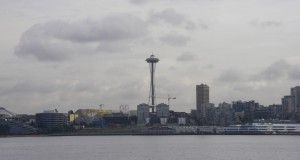 Urban—in the concrete and asphalt jungle of inner cities, life is often limited to weeds in the cracks of pavement, pigeons and rats. Rooftop gardens can revitalize the ecology of the city. Planter boxes and street trees make a striking improvement in the aesthetics of the landscape. By removing impermeable surfaces and planting in open ground, you create “Rain Gardens” that absorb life-sustaining rainwater
Urban—in the concrete and asphalt jungle of inner cities, life is often limited to weeds in the cracks of pavement, pigeons and rats. Rooftop gardens can revitalize the ecology of the city. Planter boxes and street trees make a striking improvement in the aesthetics of the landscape. By removing impermeable surfaces and planting in open ground, you create “Rain Gardens” that absorb life-sustaining rainwater
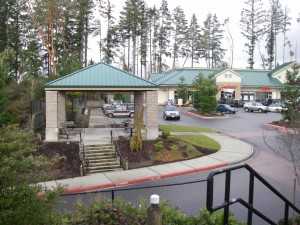 Commercial—In the Gig Harbor area we have two glaring examples of commercial development. In Gig Harbor North, many trees were preserved and subsequent landscapes were planted mostly with natives. Whereas in Uptown, all the trees were cut down and, although I commend the pedestrian concept— people are often forced to walk through mostly non-native plantings. Not only is it not very ecological, the aesthetics of the design doesn’t exhibit a true Pacific Northwestern style. Better than either of the above strategies, is to redevelop areas instead of abandoning them and encroaching on remaining wild areas.
Commercial—In the Gig Harbor area we have two glaring examples of commercial development. In Gig Harbor North, many trees were preserved and subsequent landscapes were planted mostly with natives. Whereas in Uptown, all the trees were cut down and, although I commend the pedestrian concept— people are often forced to walk through mostly non-native plantings. Not only is it not very ecological, the aesthetics of the design doesn’t exhibit a true Pacific Northwestern style. Better than either of the above strategies, is to redevelop areas instead of abandoning them and encroaching on remaining wild areas.
 Suburban—many people’s homes are on small lots. Increasing plant diversity is the best way a homeowner can improve the ecology of their property. Reduce or eliminate lawn area unless it is used as a play surface. Try to avoid geometric, single species designs. Include different heights of native trees, shrubs, groundcovers, and flowers. Help maintain community parks, green belts and wildlife corridors.
Suburban—many people’s homes are on small lots. Increasing plant diversity is the best way a homeowner can improve the ecology of their property. Reduce or eliminate lawn area unless it is used as a play surface. Try to avoid geometric, single species designs. Include different heights of native trees, shrubs, groundcovers, and flowers. Help maintain community parks, green belts and wildlife corridors.
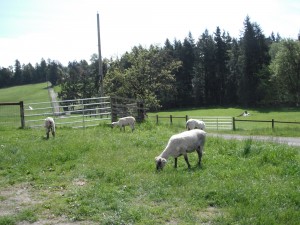 Rural (small acreage)—the historical use of land and your activities will influence how you will want to handle ecological restoration. Of utmost importance is controlling invasive species such as Scotch Broom and Himalayan Blackberry. If you can get native species established, they will care for themselves and you will have less to maintain.
Rural (small acreage)—the historical use of land and your activities will influence how you will want to handle ecological restoration. Of utmost importance is controlling invasive species such as Scotch Broom and Himalayan Blackberry. If you can get native species established, they will care for themselves and you will have less to maintain.
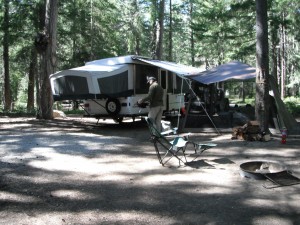 Timberland/Recreational Parkland —can be allowed to mature and grow independently (after replanting) with little management. Invasive species need to be monitored and controlled.
Timberland/Recreational Parkland —can be allowed to mature and grow independently (after replanting) with little management. Invasive species need to be monitored and controlled.
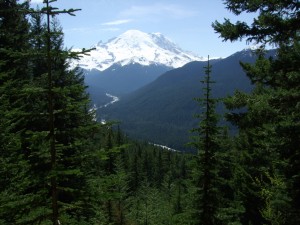 Wilderness—should be left entirely alone except to eradicate nonnative species—or to reintroduce endangered species that have disappeared from regional habitats.
Wilderness—should be left entirely alone except to eradicate nonnative species—or to reintroduce endangered species that have disappeared from regional habitats.
Humans have impacted every part of this planet to a lesser or greater degree. By improving the ecology of land under your control, you can do your part to “Think globally, act locally!”
(This article was first published in the Peninsula Gateway on March 3 , 2010)
Old growth forests are especially important habitats if only because very few remain due to logging and development. According to Arthur Kruckeberg in “The Natural History of Puget Sound Country,” it takes at least 175 to 250 years for a forest to begin to look like an old growth forest. It is in its prime between 350 to 750 years. Some individual trees may live to 1000 years old or more. If we make an analogy to human life spans as we do for dogs (7 “Dog-years” are said to be loosely analogous to 1 human-year). A hundred year-old forest wouldn’t even be a teenager yet!
An old growth forest actually has a greater diversity of life due to the accumulation of biomass and increased shrub & herb layer due to openings from fallen trees.
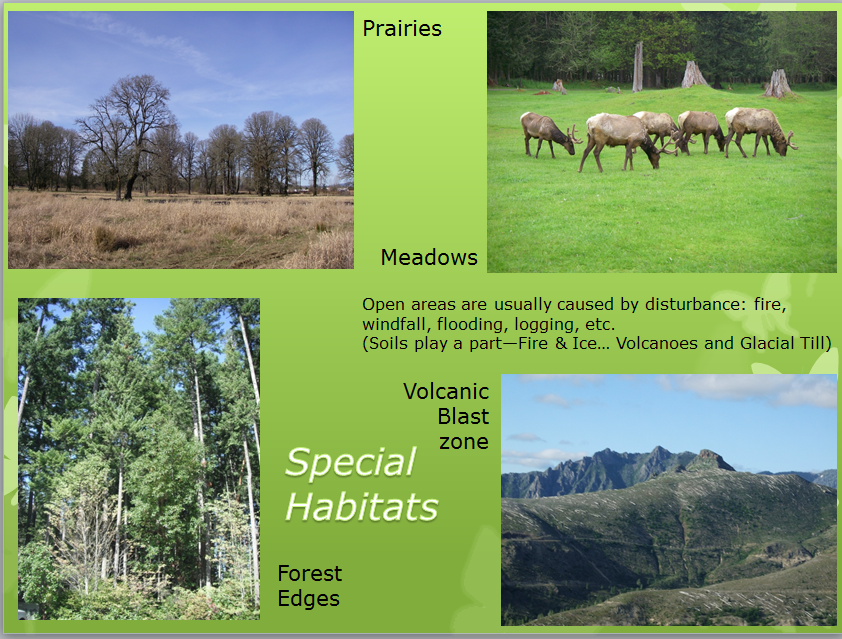 Disturbed habitats are also important because they allow different plants and animals to prosper. Hardwoods are only common on disturbed sites or special habitats such as riparian zones. Red Alder & Big-leaf Maple are the most widespread. Black Cottonwood, Oregon Ash, Big-leaf Maple, Red Alder are found on riparian & wetland areas. Pacific Madrone & Oregon White Oak are found on drier sites.
Disturbed habitats are also important because they allow different plants and animals to prosper. Hardwoods are only common on disturbed sites or special habitats such as riparian zones. Red Alder & Big-leaf Maple are the most widespread. Black Cottonwood, Oregon Ash, Big-leaf Maple, Red Alder are found on riparian & wetland areas. Pacific Madrone & Oregon White Oak are found on drier sites.
Prairies usually occur in drier areas and where the soil cannot retain much moisture or fertility. Meadows can be found in areas of frequent flooding, after forest fires, or where trees have fallen within a forest. A forest edge is an extremely valuable habitat for many wildlife species. It is an area that provides nesting sites and cover from predators. It may provide food in the form of berries, seeds, nuts or browse. Or, it may just be an area of transition for species that move between the forest and meadows.
The destructive nature of forest fire was thought to be totally detrimental for much of human history; this idea spurred the Smokey the Bear ad campaigns of the 1940’s & 50’s and the construction of lookout towers in national forests. In more recent decades, ecologists have become aware that natural forest fires are often beneficial, opening up areas that allow other organisms to move in to “restart” ecological succession. Small forest fires also reduce the “fuel load” which could cause larger, more destructive forest fires in the future. And, in fact some tree & shrub seeds need fire to be released from their cones or to break through hard seed coats before they can germinate.
We have been able to witness the recovery of ecosystems after forest fires and even after huge, widespread disasters, such as the eruption of Mount St. Helens. Life returns to recolonize, starting anew. Just as in the whole history of life on earth, the descendants of organisms that survive mold the living landscape. The interactions of each species contribute a strand to the web-of-life as each competes for earth’s precious resources.
Wetland Habitats
Water is essential to all life as we know it. All plants, animals and microorganisms need water; although how much they need and how often they need it varies between species. Wetlands are the only place that fish, tadpoles, other amphibians and many invertebrates can survive. Other species live nearby so that they can access the water or prey on the species that live there or that come to congregate at the local watering hole.
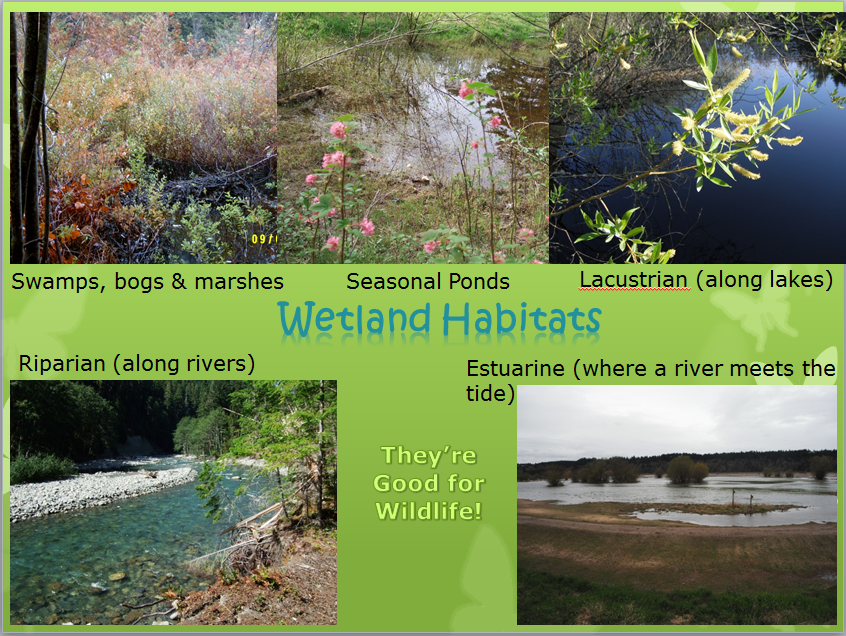 Amphibians, such as frogs, are considered an indicator species of the health of a habitat; they are very sensitive to pollution. Swamps, seasonal ponds and lakes are all important habitats for amphibians. Numerous insects and other invertebrates provide food for larger animals in all wetland habitats. Riparian habitats are important for salmon and animals that feed on salmon. Estuaries are important for many crustaceans, mollusks, and water birds.
Amphibians, such as frogs, are considered an indicator species of the health of a habitat; they are very sensitive to pollution. Swamps, seasonal ponds and lakes are all important habitats for amphibians. Numerous insects and other invertebrates provide food for larger animals in all wetland habitats. Riparian habitats are important for salmon and animals that feed on salmon. Estuaries are important for many crustaceans, mollusks, and water birds.
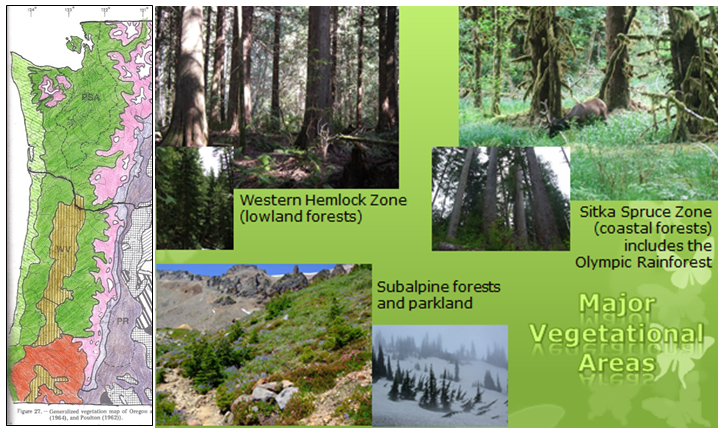
Ecologists separate our region into major vegetational areas– the Puget Sound Area (PSA) is a special region within the “Western Hemlock Zone” (See figure above). The Western Hemlock Zone lies between the coastal Sitka Spruce Zone and Subalpine Forests , extending from British Columbia to the northern California coast. Alpine regions are at the highest mountain tops. Heading east there is a narrow Mixed Douglas Fir/Grand Fir Region , then a Ponderosa Pine region before transitioning to drier steppe habitats. In Oregon, the Western Hemlock Zone is split by the drier Willamette, Umpqua & Rogue Valleys nestled between the Coast Ranges and Siskiyous to the west and the Cascade Mountains to the east. Southwest Oregon is primarily a mixed Conifer & Evergreen Region .
The Western Hemlock Zone is named for its climax species, which is the species that theoretically would come to dominate, barring any disturbance. Today, Douglas Fir often is dominant due to logging, burning or other disturbances that have occurred over the last 200 years.–but even old-growth stands retain several Douglas Firs because of their longevity (750-1000 years or more!).
The three major coniferous trees found in the Western Hemlock Zone are Douglas Fir, Western Hemlock, and Western Red Cedar. Grand Fir, Sitka Spruce, Western White Pine are also found sporadically. Western White Pine & Shore Pine are common on glacial soils in the Puget Sound. Western Yew is subordinately found beneath the canopies of larger conifers.
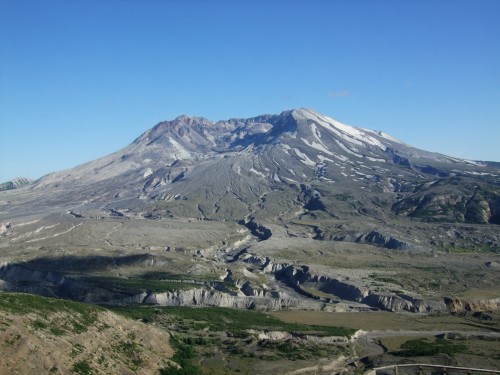
Before we think about planting, it is a good idea to consider what kind of soil we are planting in.
Most of our soils in the Pacific Northwest arise from the interplay between volcanoes & glaciers. Volcanoes bring magma up from underneath the earth’s surface. The magma becomes lava as it erupts from a volcano and then cools to become igneous rocks. Glaciers erode the rocks as they move down the mountain. These massive rivers of ice grind rocks into smaller and smaller pieces.
The Puget Sound was created from the action of glaciers advancing and retreating over many Ice Ages. Just 20,000 years ago, the Puget Sound was covered in a mile-high sheet of glacial ice.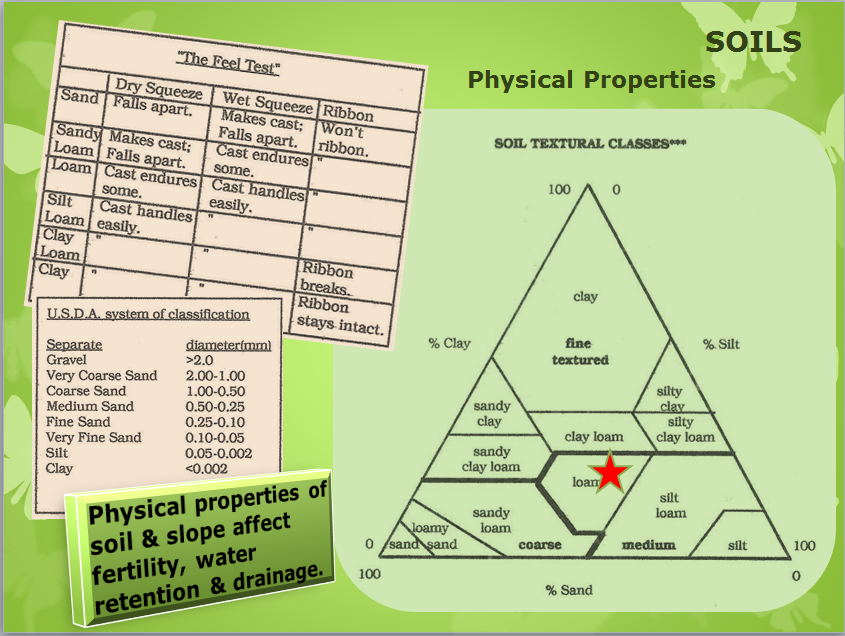
The type of soil you have in your yard will influence your success in growing different plant species. The figure above shows the USDA classification system for soil particles. For growing plants, we are mainly interested in the portions that are sand, silt or clay. Sand, by itself drains quickly and is not able to retain many nutrients. Silt is intermediate in size between sand and clay. Clay, by itself, prevents water from draining, but clay particles are good at holding nutrients.
Soils are also classified by the relative percentages of sand, silt and clay as indicated by the Soil Textural Class Triangle. Loam soils, the most ideal, have about 33% sand, a 25% clay and 42% silt.
You can “guesstimate” your soil class by doing a feel test. For the feel test you take a small amount of soil and squeeze it in your hand. When you open your hand, you look to see how well the soil holds together. If it holds together, try to pinch the cast between your forefinger and thumb to a make a flattened ribbon to determine the amount of clay. If your soil has too much sand or clay, you may want to consider incorporating appropriate constituents to improve its structure.
The pore space between the particles is important for drainage and for gas exchange. Sometimes soils become compacted due to heavy traffic either by foot or by machines. Rototilling helps to loosen, aerate and mix soil but only to the depth of the rototiller. (It also helps to make removing weeds easier.) Some gardeners shun rototilling and depend upon natural systems to keep their soil pliable.
Composted organic matter is also an important component of soils. It is any material derived from a living organism. It adds nutrients, increases nutrient-holding capacity, moisture retention and encourages microbial activity. A soil high in organic matter usually has a dark, rich color. Organic matter may be added to soils as green manures (cover crops) that are plowed in prior to planting, or by incorporating animal manures or compost. Many soil mixes used in horticulture, especially potting mixes, are “soil-less.” They may contain compost, peat moss, bark, perlite, pumice and/or vermiculite. A “green” alternative to peat (which is mined out of ancient bogs) is coconut fiber (coir).
Another important factor affecting plant growth that people often overlook is soil pH; pH is the relative acidity or alkalinity. It affects what nutrients are available for uptake by plants. Most plants prefer a slightly acid soil (pH 5.5-7.0). On a scale from 0 to 14, Seven is neutral, the pH of distilled water; less than 7 is acid; greater than 7 is alkaline.) It is a good idea to test your soil, especially for pH. Test kits list recommended pH ranges for various crops and will tell you how to calculate the amount of amendments, such as lime, that should be added to your bed.
The microfauna, (bacteria, algae, fungi, insects, and worms) of soil also is important. Charles Darwin studied and wrote a book about worms, “The formation of vegetable mould, through the action of worms.” The book is about the important role that worms play in decomposing and translocating organic matter in the soil and aerating the soil. He writes: “I was thus led to conclude that all the vegetable mould over the whole country has passed many times through, and will again pass many times through, the intestinal canals of worms. Hence the term “animal mould” would be in some respects more appropriate than that commonly used of “vegetable mould.” Many bacteria, fungi and insects are also “decomposers.” Some bacteria help plants by “fixing” nitrogen; absorbing it from the air and making it available to plants. Some fungi, such as mycorrhizae assist plants with nutrient and water uptake. Algae play a role in dissolving minerals.
Epiphytes, plants that grow in trees do not need soil–they are able to absorb water and nutrients directly from the air. Most plants that we grow, however, are terrestrial plants, plants that grow in soil. (I have never been very interested in “high-tech” horticulture such as hydroponics—such systems are expensive, involve mixing a concoction of water soluble chemicals and are unnecessary as long as there is space to grow plants naturally in soil).
The plants and trees also affect the fertility of the soil as layers of organic matter are deposited and decomposed by the action of microorganisms.
Feature Photograph: Mt. St. Helens